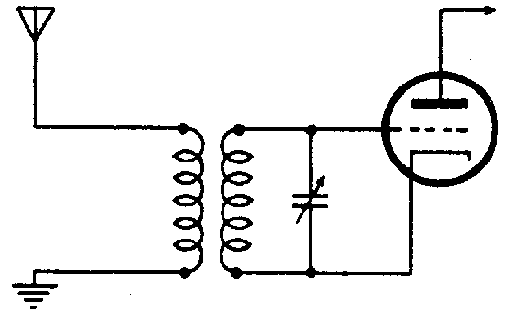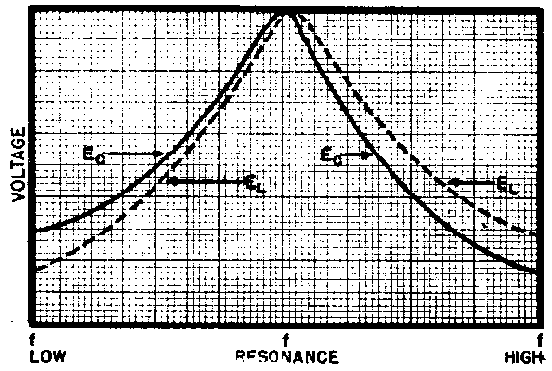 |
If the receiver is tuned to a strong local station, the signal should be heard
at this point.
Isolating and simplifying the input circuit, we have a circuit as shown in
Fig. 2.

Fig. 2. First r.f. amplifier stage.
|
The secondary side of the antenna coil is a seris circuit consisting of
inductance, capacitance, and a small amount of resistance. Series resonance
is utilized to obtain maximum voltage across the condenser.
To understand that this is a series resonant circuit, we remember that a
series circuit is one in which all the components are in series with the
source. Here the source voltage is the e.m.f. induced in the secondary by
the current in the primary. The cuircuit may be redrawn as shown in Fig. 3.

Fig. 3. The equivalent circuit of Fig. 2.
|
ES is the voltage induced in the secondary coil. If the Frequency
of ES is varied, the current I becomes a maximum at resonance.
The voltage EL and the voltage EC also reach maximum
value at resonance. This is shown in the curve of Fig. 1.

Fig. 1. Resonance curves of the tuned circuit illustrated in Fig. 2.
|
In the receiver, resonance is obtained not by carying the frequency but by
tuning the resonant circuit to the frequency desired. For that setting of
the tuned circuit, the desired signal will set up a greater voltage than is
produced by any other signal having the same intensity but of a different
frequency.
When a voltage appears across the secondary of the antenna coil it means
that there is a voltage across the primary also, and this is the voltage
from antenna post to ground. Because resonance is established in the
secondary rather than in the primary, the secondary circuit is a necessary
factor in any discussion involving the primary voltage.
Trouble
If no signal is heard it means that there is no voltage across the primary
of the antenna coil. Usually this indicates a short circuit, either in the
primary or in the secondary.
It might be suggested that the primary could be open. To pusrsue this line
of thought, the following experiment is instructive. Take any ordinary
antenna coil, even a very early type, and connect it between the antenna
and ground.
If the probe is now applied to ANT, a signal will be heard. More than one
signal may bve present if there are several strong local stations. The
simple coil is not selective. It offers a high impedance to all voltages
at radio frequency so that any r.f. voltage picked up by the antenna is
available for amplification.
In the average neighborhood there is also a 60-cycle field that sets up a
voltage in the antenna circuit. At this low frequency the impedance of the
antenna coil is very low and the 60-cycle hum voltage is usually neglible.
Next, let us remove the antenna coil and substitute a resistor of high
value, say one megohm. Now we have a high impdeance to ground but it is
an impedance that is nondiscrimnating as to frequency. The small antenna
currents set up IR drops across the resistance and these IR drops are
independant of the frequency. Consequently, the voltage set up by any
signal depends only on the field strength of that signal (assuming that
the antenna itself is nonselective). Usually, it will be found that the
60-cycle field predominates and a strong hum will be heard. A powerful
local station may be heard faintly through the hum and noise.
Finally, we remove the resistor and thus create an open circuit between
antenna and ground. The impedance at 60-cycles is now very great. At
radio frequencies the impedance is relatively lower because the stray
capacitances (and the inpu capacitance of the tester) offer a path to
ground. Now the hum will be pronounced and no r.f. signal will be heard.
From these experiments it can be understood that the operation of tuning
is simply this: The antenna circuits are so adjusted that r.f. waves of
the desired frequency set up a considerably greater voltage on the grid
of the first tube than do wave of any other frequency. The tuning is
done usually be means of a series resonant circuit inductively coupled
to the antenna.
|
 |



